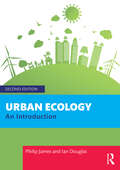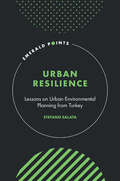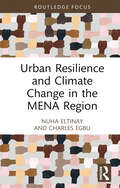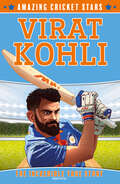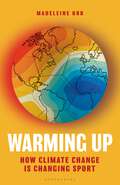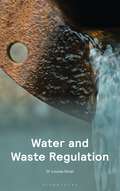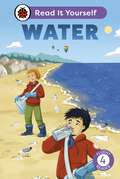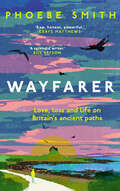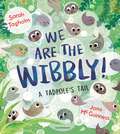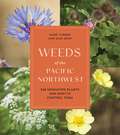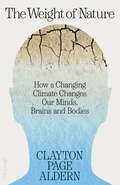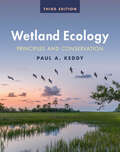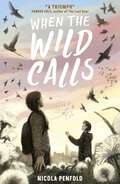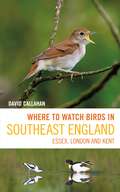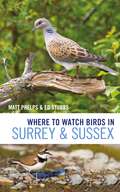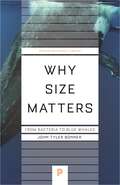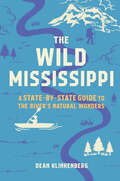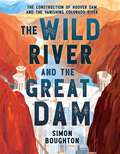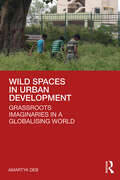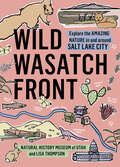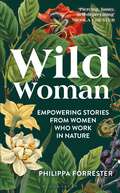- Table View
- List View
Urban Ecology: An Introduction
by Philip James Ian DouglasThis fully revised second edition reflects the great expansion in urban ecology research, action, and teaching since 2015. Urban ecology provides an understanding of urban ecosystems and uses nature-based techniques to enhance habitats and alleviate poor environmental conditions. Already the home to the majority of the world’s people, urban areas continue to grow, causing ecological changes throughout the world. To help students of all professions caring for urban areas and the people, animals, and plants that live in them, the authors set out the environmental and ecological science of cities, linkages between urban nature and human health, urban food production in cities, and how we can value urban nature. The authors explore our responsibilities for urban nature and greening, ecological management techniques, and the use of nature-based solutions to achieve a better, more sustainable urban future and ensure that cities can climate change and become more beautiful and more sustainable places in which to live. This text provides the student and the practitioner with a critical scientific overview of urban ecology that will be a key source of data and ideas for studies and for sound urban management.
Urban Resilience: Lessons on Urban Environmental Planning from Turkey (Emerald Points)
by Stefano SalataAdvocating for the reintroduction of natural areas and biodiverse green spaces within our cities, Urban Resilience stems from the two years’ experience living and teaching ecological planning in Turkey. What is resilience? What does it mean practically to design resilient cities? Demonstrating that the expansion of the ecological footprint of urban areas is no longer sustainable, Stefano Salata underscores that authentic resilience in urban planning necessitates embracing the reduction and de-sealing of urban surfaces, which he advocates for as the sole viable means of confronting the challenges posed by climate change. Providing a fresh methodological outlook on urban adaptation, Salata introduces a novel approach to understanding resilience, streamlining the key components of knowledge that urban planners need to acquire in order to effectively address the challenges posed by climate change. Supplemented with short personal reflections on Turkish space and society, this study explores the societal significance of embracing a new cultural paradigm characterized by reduced consumerism. Taking the Turkish case as a pioneering testing ground, Salata substantiates the potential of resilient approaches for urban transformation, affording us the opportunity to evaluate the efficacy of various solutions across the globe.
Urban Resilience: Lessons on Urban Environmental Planning from Turkey (Emerald Points)
by Stefano SalataAdvocating for the reintroduction of natural areas and biodiverse green spaces within our cities, Urban Resilience stems from the two years’ experience living and teaching ecological planning in Turkey. What is resilience? What does it mean practically to design resilient cities? Demonstrating that the expansion of the ecological footprint of urban areas is no longer sustainable, Stefano Salata underscores that authentic resilience in urban planning necessitates embracing the reduction and de-sealing of urban surfaces, which he advocates for as the sole viable means of confronting the challenges posed by climate change. Providing a fresh methodological outlook on urban adaptation, Salata introduces a novel approach to understanding resilience, streamlining the key components of knowledge that urban planners need to acquire in order to effectively address the challenges posed by climate change. Supplemented with short personal reflections on Turkish space and society, this study explores the societal significance of embracing a new cultural paradigm characterized by reduced consumerism. Taking the Turkish case as a pioneering testing ground, Salata substantiates the potential of resilient approaches for urban transformation, affording us the opportunity to evaluate the efficacy of various solutions across the globe.
Urban Resilience and Climate Change in the MENA Region (Routledge Focus on Environment and Sustainability)
by Nuha Eltinay Charles EgbuThis book provides an overview of the geopolitical context and climate change risk profile of the Middle East and North Africa (MENA) Region. Mapping existing scientific literature and key reports on MENA climate change impacts and future projections, Nuha Eltinay and Charles Egbu establish links between the Conference of the Parties (from COP26, COP27 to COP28) Glasgow–Sharm el-Sheikh Work Program for Progress on the Global Goal on Adaptation, and regional climate adaptation financing targets, national government investments, and human security in local case studies. They also address gaps in disaster risk reduction institutional governance for sustainable development in the region. The authors move beyond the existing theoretical understanding of urban resilience to investigate how it is being measured and assessed in MENA in alignment with the IPCC’s climate change adaptation indicators. Finally, they explore how disasters and conflict displacement vulnerabilities and fragility affecting the communities most in need are being measured and integrated into cities’ resilience action plans and national disaster risk policies. Providing guidance and policy recommendations based on empirical research and key stakeholder engagement observations, this book will be of great interest to students, scholars, and professionals who are researching and working in the areas of climate change, urban planning, and environmental policy and governance. As this book comes out just after the closure of The United Nations Climate Change Conference COP28 negotiations, it sets the scene for pre-COP regional context, and paves the way for researchers and practitioners to undertake post-COP28 key takeaways and multi-level government commitments into action, for better climate mitigation and adaptation investments, resilient and sustainable future for all.
Urban Resilience and Climate Change in the MENA Region (Routledge Focus on Environment and Sustainability)
by Nuha Eltinay Charles EgbuThis book provides an overview of the geopolitical context and climate change risk profile of the Middle East and North Africa (MENA) Region. Mapping existing scientific literature and key reports on MENA climate change impacts and future projections, Nuha Eltinay and Charles Egbu establish links between the Conference of the Parties (from COP26, COP27 to COP28) Glasgow–Sharm el-Sheikh Work Program for Progress on the Global Goal on Adaptation, and regional climate adaptation financing targets, national government investments, and human security in local case studies. They also address gaps in disaster risk reduction institutional governance for sustainable development in the region. The authors move beyond the existing theoretical understanding of urban resilience to investigate how it is being measured and assessed in MENA in alignment with the IPCC’s climate change adaptation indicators. Finally, they explore how disasters and conflict displacement vulnerabilities and fragility affecting the communities most in need are being measured and integrated into cities’ resilience action plans and national disaster risk policies. Providing guidance and policy recommendations based on empirical research and key stakeholder engagement observations, this book will be of great interest to students, scholars, and professionals who are researching and working in the areas of climate change, urban planning, and environmental policy and governance. As this book comes out just after the closure of The United Nations Climate Change Conference COP28 negotiations, it sets the scene for pre-COP regional context, and paves the way for researchers and practitioners to undertake post-COP28 key takeaways and multi-level government commitments into action, for better climate mitigation and adaptation investments, resilient and sustainable future for all.
Virat Kohli (Amazing Cricket Stars #2)
by null Clive GiffordMeet the champion Indian batter, Virat Kohli, in this stunning unofficial biography! From when he was a small boy, Virat Kohli’s special talent for cricket has wowed those around him – his family, friends, and eventually, his colleagues on the Indian national team. His dedication to his training and teammates, and his incredible aptitude with a bat have placed him firmly among the ranks of the best cricketers of all time. Follow this impressive cricketer as he bats his way to international glory. Look out for the rest of the Amazing Cricket Stars series: Ben Stokes Heather Knight Mitchell Starc
Warming Up: How Climate Change is Changing Sport
by Madeleine OrrThe world of sport has a new opponent: climate change.In recent years, a world championship marathon was held at midnight to avoid the blistering sun. Professional athletes needed oxygen tanks to play during wildfire season in California. Players collapsed and play was suspended amid the heat and bushfire smoke at the Australian Tennis open. Ski resorts in the Alps have turned into ghost towns. Golf courses are sinking into the sea. And then there's the Qatar World Cup, among the greatest follies in sporting history, one that saw hundreds (perhaps thousands) of heat-induced deaths before a ball was even kicked. The threat climate change poses to sport is clear, but with billions of participants and fans around the world who rely on the sector for entertainment, jobs, fitness and health, this is one industry we can't afford to lose. In this book, Madeleine Orr shows it doesn't have to be this way. There are ways to mitigate, and perhaps counter, even the worst elements of climate change. A world-leading sport ecologist, Madeleine interviews athletes, coaches, politicians and thought-leaders to learn more about the inevitable consequences for this trillion-dollar industry. From the frontlines of climate change, Warming Up takes readers through a play-by-play of how global warming is already impacting sport, and how the sports world can fight back.
Water and Waste Regulation
by Dr Louise SmailWater pollution law is the most developed of the pollution control systems. This title contains a comprehensive account of water and waste legislation plus a detailed interpretation of the relevant statutory provisions and associated case law.This book includes:- A detailed interpretation of the relevant statutory provisions and associated case law- The impact of Brexit on current regulations- Discussions surrounding UK desalination plants, end of life vehicles and nature conservation- The changes in international regulations and the impact that this has on UK water and waste regulation- The regulation of water quality standards, water pollution control, fisheries, navigation, flood, coastal protection and marine pollution with a wide range of water pollution offencesThe detailed treatment of the issues involved will enable environmental and energy law practitioners to feel confident in what is a complicated area of law.This title is included in Bloomsbury Professional's Environmental Law online service.
Water: Read It Yourself - Level 4 Fluent Reader (Read It Yourself)
by LadybirdHumans, animals, and plants need water every day to survive. But where does it come from? How do we know if it is safe to drink? Learn all about how water is saved, cleaned, and shared in this fact-filled book. Water is from Fluent Reader Level 4 and is ideal for more fluent readers aged from 7+ who are starting to read independently.Each book has been carefully checked by educational and subject consultants and includes comprehension puzzles, book band information, and tips for helping children with their reading. With five levels to take children from first phonics to fluent reading and a wide range of different stories and topics for every interest, Read It Yourself helps children build their confidence and begin reading for pleasure.
Wayfarer: Love, Loss And Life On Britain's Ancient Paths
by Phoebe SmithA woman’s tale of the transformative power of walking Britain’s ancient pilgrim paths ‘Raw, honest, powerful. I couldn't put it down.’ Cerys Matthews
We Are the Wibbly!
by Sarah TagholmThe funny, heartfelt and irresistible story of one small creature's epic journey from frogspawn to frog.OH MY CRIKEYS!Doesn't life move fast? One moment you're in the Wibbly, relaxing with your Wibbly friends. The next, they've all grown tails and turned into tadpoles! And what's more, they are bursting OUT of the Wibbly ... AND you've got to keep up! Some tadpoles don't feel ready to become frogs.And some never wanted to become tadpoles in the first place. This heartwarming, hilarious story speaks perfectly to the anxiety that children can feel about keeping up with those around them – perfect for fans of Oi Frog! and Tad by Benji Davies.
Weeds of the Pacific Northwest: 368 Unwanted Plants and How to Control Them
by Sami Gray Mark TurnerA comprehensive guide to the most common weeds of the Pacific Northwest, with essential information on their management and eradication Weeds are everywhere. They crowd out valuable agricultural crops, compete with the tomatoes and beans in your vegetable garden, spread rampantly along roadsides, and pop up from the tiniest cracks in sidewalks. In order to manage them, we must first learn how to identify them. Weeds of the Pacific Northwest is a guide to identifying, controlling, and eradicating over 300 species of weeds that gardeners and homeowners are likely to encounter in Northern California, Oregon, Washington, and British Columbia. Though they can all cause trouble, each weed is different. The hundreds of user-friendly photographs and detailed descriptions of each species here ensure that you can spot and treat any weed in your path. As the experts behind this book demonstrate, some plants can be killed by eating them, some by digging, some by smothering, and some only by the judicious application of chemical herbicides—and it is very important for you and your neighbors to know and understand the differences.
The Weight of Nature: How a Changing Climate Changes Our Minds, Brains and Bodies
by Clayton Aldern'Penetrating, intensely personal, and impossible to put down, this is a book you need to read.' Annie Proulx, winner of the Pulitzer Prize'This book is a triumph.' Bill McKibbenA riveting, revelatory account of how the climate emergency is changing us from the inside outIt is now inarguable that climate change threatens the future of life on Earth. But in The Weight of Nature, award-winning journalist and neuroscientist Clayton Page Aldern shows that the warming climate is not just affecting our planet – it is affecting our brains and bodies too. Drawing on seven years of ground-breaking research, Aldern documents a burgeoning public health crisis that has gone largely unreported. Eco-anxiety, he shows us, is just the tip of the iceberg. The rapidly changing environment is directly intervening in our brain health, behaviour, decision-making and cognition in real time, affecting everything from spikes in aggravated assault to lower levels of productivity and concentration, to the global dementia epidemic. Travelling the world to meet the scientists and doctors unravelling the tangled connections between us and our environment, and reporting the stories of those who are already feeling these shifts most keenly, Aldern shows how climate change isn’t just around us, but within us. Lucid, urgent and at times deeply moving, The Weight of Nature is a revelation, bringing to light the myriad ways in which the natural world tugs and prods at the decisions you make; how it twists and folds your memories and mental states; how this nebulous everywhere we call the environment is changing our very humanity from the inside out.
When the Wild Calls (Where the World Turns Wild #2)
by Nicola PenfoldHaving escaped their city, Juniper Greene and her brother Bear have settled in Ennerdale with their dad and his family. Every day the wild introduces them to a new wonder, but Juniper can't stop worrying about her grandmother and best friend left behind. When she hears news that disease has entered the city, she's determined to bring her loved ones to safety. Trapped in a city riddled with disease and run by a ruthless leader, Etienne longs for the wild. With the guards becoming more aggressive to counteract the growing rebellion, Etienne's prepared to fight for his freedom. But will he be able to protect himself and keep those around him safe until Juniper returns from the wild?
Where to Watch Birds in Southeast England: Essex, London and Kent (Where to Watch Birds)
by David CallahanThe definitive site guide to a surprisingly bird-rich corner of England – Kent, Essex and the Greater London area.From the deep forests of Kent to the low-lying mudflats, beaches and saltmarshes of the Greater Thames Estuary, this ecologically rich area of England attracts vast numbers of wildfowl and waders. The region boasts many internationally and nationally important reserves including Rainham Marshes and Cliffe Pools, while Dungeness in Kent is one of Britain's best known birding hotspots for vagrant species such as Penduline Tit and Kentish Plover. London itself contains numerous birdwatching sites including Barnes and Woodberry Wetlands, along with some of the best spots in Britain for scarcities such as Lesser Spotted Woodpecker and Black Redstart. From Marsh Harrier and Firecrest to Curlew and Lapwing, there is plenty for birdwatchers to enjoy while exploring the parks, wetlands, woodlands and coast of southeast England. Written by life-long birdwatcher David Callahan, this is the definitive guide to the birding highlights of the region. It contains a comprehensive review of all the major sites and many lesser-known ones, with maps, notes on access, and information on target species and when to visit. Where to Watch Birds in Southeast England is indispensable for any birder exploring the region, or anyone in London wanting to head out to the countryside and enjoy a slice of our rich avian heritage.
Where to Watch Birds in Surrey and Sussex (Where to Watch Birds)
by Matthew Phelps Ed StubbsThis site guide covers the counties of East Sussex, West Sussex and Surrey, including sites in southwest Greater London. From the heaths of Surrey to the chalky grassland of the North and South Downs, the great forests of the Weald and the headlands, shingle beaches and river valleys of England's south coast, these three counties are a bird-rich part of the country, with perhaps the most diverse range of habitats in the country, and all within easy distance of London, the southwest part of which contains birding sites such as Barnes wetland centre.This new book by Matthew Phelps and Ed Stubbs is the definitive guide to the birding highlights of the region. It contains a comprehensive review of all the major sites, and many lesser-known ones, with maps, notes on access, and information on target species and when to visit. Where to Watch Birds in Surrey and Sussex is indispensable for any birder heading to this bird-rich region, or anyone in London who wants to head south to enjoy some of the best birding England can offer.
Why Size Matters: From Bacteria to Blue Whales (Princeton Science Library #142)
by John Tyler BonnerJohn Tyler Bonner, one of our most distinguished and creative biologists, here offers a completely new perspective on the role of size in biology. In his hallmark friendly style, he explores the universal impact of being the right size. By examining stories ranging from Alice in Wonderland to Gulliver's Travels, he shows that humans have always been fascinated by things big and small. Why then does size always reside on the fringes of science and never on the center stage? Why do biologists and others ponder size only when studying something else—running speed, life span, or metabolism?Why Size Matters, a pioneering book of big ideas in a compact size, gives size its due by presenting a profound yet lucid overview of what we know about its role in the living world. Bonner argues that size really does matter—that it is the supreme and universal determinant of what any organism can be and do. For example, because tiny creatures are subject primarily to forces of cohesion and larger beasts to gravity, a fly can easily walk up a wall, something we humans cannot even begin to imagine doing.Bonner introduces us to size through the giants and dwarfs of human, animal, and plant history and then explores questions including the physics of size as it affects biology, the evolution of size over geological time, and the role of size in the function and longevity of living things.As this elegantly written book shows, size affects life in its every aspect. It is a universal frame from which nothing escapes.
Why Size Matters: From Bacteria to Blue Whales (Princeton Science Library #142)
by John Tyler BonnerJohn Tyler Bonner, one of our most distinguished and creative biologists, here offers a completely new perspective on the role of size in biology. In his hallmark friendly style, he explores the universal impact of being the right size. By examining stories ranging from Alice in Wonderland to Gulliver's Travels, he shows that humans have always been fascinated by things big and small. Why then does size always reside on the fringes of science and never on the center stage? Why do biologists and others ponder size only when studying something else—running speed, life span, or metabolism?Why Size Matters, a pioneering book of big ideas in a compact size, gives size its due by presenting a profound yet lucid overview of what we know about its role in the living world. Bonner argues that size really does matter—that it is the supreme and universal determinant of what any organism can be and do. For example, because tiny creatures are subject primarily to forces of cohesion and larger beasts to gravity, a fly can easily walk up a wall, something we humans cannot even begin to imagine doing.Bonner introduces us to size through the giants and dwarfs of human, animal, and plant history and then explores questions including the physics of size as it affects biology, the evolution of size over geological time, and the role of size in the function and longevity of living things.As this elegantly written book shows, size affects life in its every aspect. It is a universal frame from which nothing escapes.
The Wild Mississippi: A State-by-State Guide to the River's Natural Wonders
by Dean KlinkenbergDiscover the amazing flora and fauna of the Mississippi River—and the best ways to explore it, state by state! Did you know that one-quarter of all North American fish species are native to the Mississippi? Or that it shelters 300 species of birds during seasonal migrations? The Mississippi River runs through the heart of the nation, shaping its history and identity. But few of us understand its essences. It&’s a life-giving force that sustains thriving ecosystems across wetlands, prairies, and bluffs. In The Wild Mississippi, Dean Klinkenberg not only shares the wonders of the river, but he also shows you where to experience them firsthand. Pick up this must-read guide and get ready to experience the river wild! You&’ll discover: Hiking, biking, and paddling spots More than 160 parks, forests, and wildlife refuges Natural history museums and aquariums Excursions from Minneapolis, St. Louis, Memphis, New Orleans, and more
The Wild River and the Great Dam: The Construction of Hoover Dam and the Vanishing Colorado River
by Simon Boughton★ "In this detailed and informative work, Boughton chronicles the construction of the Hoover Dam via compellingly comprehensive text." —Publishers Weekly, starred review ★ "This well-written narrative is bound to become the authority on this modern American marvel." —Booklist, starred review"A fascinating blend of social and environmental history and engineering." —Kirkus Reviews "Truly breathtaking. This is a powerful story and like the water slowly rising behind that concrete barrier, it becomes more powerful with each page turn." —David Macaulay, two-time recipient of the Caldecott Medal and creator of the bestselling The Way Things Work"An exciting mix of research, storytelling, and an astounding true story—one that&’s still unfolding today." —Steve Sheinkin, three-time National Book Award finalist and Newbery Honor author of Bomb Discover the complicated history behind the construction of Hoover Dam—one of the country&’s most recognizable and far-reaching landmarks—and its lasting political and environmental effects on the Colorado River and the American West. At the time of its completion in 1936, Hoover Dam was the biggest dam in the world and the largest feat of architecture and engineering in the country—a statement of national ambition and technical achievement. It turned the wild Colorado River into a tame and securely managed water source, transforming millions of acres of desert into farmland while also providing water and power to the fast-growing population of the Southwest. The concrete monolith quickly became a symbol of American ingenuity; however, its history is laden with contradiction. It provided work for thousands, but it was a dangerous project that exploited desperate workers during the Depression. It helped secure the settlement and economies of the Southwest, but at the expense of Indigenous peoples and the environment; and it created a dependency on the Colorado River&’s water, which is under threat from overuse and climate change. Weaving together elements of engineering, geography, and political and socioeconomic history, and drawing heavily from unpublished oral histories taken from dam workers and their families, Simon Boughton&’s thoughtful and compelling debut—featuring historical photographs throughout—follows the construction and impact of Hoover Dam, and how its promise of abundance ultimately created a river in crisis today.
Wild Spaces in Urban Development: Grassroots Imaginaries in a Globalising World
by Amartya DebThis fascinating book examines how microsites of spontaneous nature can reframe our understanding of the relationship between urban development and green space. Metropolitan cities are facing stark inequalities of green space distribution, hindering goals of sustainable development. But outside of human control, spontaneous nature grows in spaces that are neglected or are unaccounted for. Drawing on existing literature and primary research in a range of towns and cities, including Quito in Ecuador, Bengaluru and Kolkata in India, and Whitby in the United Kingdom, the book delves into the morphology, meanings, and values of those small-scale assemblages of wild growth which are typically overlooked. Discussing instead how such settings can be integrated into everyday urban life, the book offers a fresh perspective on issues around green infrastructure, heritage conservation, and environmental education, enabling cities worldwide to become more nature-positive. A unique examination of an under-researched topic, this book will appeal to students, researchers, and professionals across landscape architecture, urban planning, urban ecology, and all related fields.
Wild Spaces in Urban Development: Grassroots Imaginaries in a Globalising World
by Amartya DebThis fascinating book examines how microsites of spontaneous nature can reframe our understanding of the relationship between urban development and green space. Metropolitan cities are facing stark inequalities of green space distribution, hindering goals of sustainable development. But outside of human control, spontaneous nature grows in spaces that are neglected or are unaccounted for. Drawing on existing literature and primary research in a range of towns and cities, including Quito in Ecuador, Bengaluru and Kolkata in India, and Whitby in the United Kingdom, the book delves into the morphology, meanings, and values of those small-scale assemblages of wild growth which are typically overlooked. Discussing instead how such settings can be integrated into everyday urban life, the book offers a fresh perspective on issues around green infrastructure, heritage conservation, and environmental education, enabling cities worldwide to become more nature-positive. A unique examination of an under-researched topic, this book will appeal to students, researchers, and professionals across landscape architecture, urban planning, urban ecology, and all related fields.
Wild Wasatch Front: Explore the Amazing Nature in and around Salt Lake City (Wild Series)
by Natural History Museum of UtahA vibrant, informative guide to the unexpected nature in Salt Lake City and the surrounding area. Set out on a field trip with the experts from the Natural History Museum of Utah. In this book, you&’ll learn about over 100 local species, both plants and animals. Be on the lookout for painted turtles in Ogden, spot pelicans soaring over Provo, and identify pavement mushrooms in Salt Lake City. Equal parts field guide and trip planner, Wild Wasatch Front reveals the unexpected nature thriving in parks, beside urban streams, along local trails… and maybe even in your own backyard.
Wild Woman: Empowering Stories from Women who Work in Nature
by Philippa ForresterAn engaging blend of conservation stories and humorous, personal anecdotes from Philippa Forrester about women who, like her, choose to live and work in the wild.Surviving in the wilderness has long been associated with men, and conservation and environmental biology have traditionally been male-dominated subjects. Yet many remarkable women also choose to live and work in wild and challenging landscapes. In Wild Woman, Philippa Forrester considers the grit and determination required for women to maintain connections to wildlife and shares stories of female conservation heroes and other extraordinary wild women working in nature. Talking to women from around the world, Philippa studies and celebrates what it means to be a wild woman. From the sixteenth-century botanist who was the first woman to circumnavigate the globe to modern-day women responding to bear attacks in Yellowstone, working to rewild reserves in South Africa, photographing Caribou in the Arctic and more, Philippa examines how these women benefit from a life spent in the wilderness and also considers what the natural world gains from them. Relating some of her own experiences from three decades spent travelling around the world and working in some of the wildest places on Earth, Philippa asks: what does it take for a woman to live or work in the wild?
